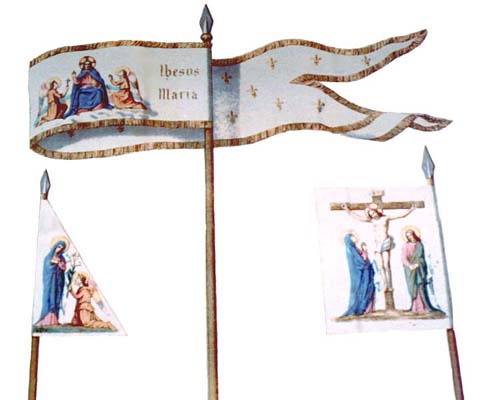
One purpose of the trial of Joan of Arc in 1431 was to convict her of sorcery or heresy. I am not sure what the following questions were meant to prove but it seems likely that the court was trying to find some superstitious practices associated with banners that they could use against her. Joan sharply rebutted all of these questions, so it is hard to say that any such practices took place in her case. However, the ecclesiastical court must have got their ideas from someplace.
All the question that follow were put to Joan by court officers or judges.
Asked if, when her King set her to work and she had her standard made, the other men-at-arms did not have pennons made in the manner and following the example of her opinion, she replied: "It is well known that lords use their own arms." Item, she also said that some of her companions-at-arms did have pennons at their pleasure but others did not.
Asked of what material they had them made, whether this was of linen or of woolen cloth, she answered that it was of white satin, and on some there were fleurs-de-lys. And Joan only had two or three lances in her company, but her companions-in-arms sometimes had pennons made resembling hers and they did this only to distinguish their men from others.
Asked if the pennons were very often renewed, she replied: "I do not know. When the lances were broken, new ones were made."
Asked if she had sometimes said that the pennons made to resemble hers were more fortunate, she answered that sometimes she certainly did say to her men: "Drive boldly into the English," and she herself would go there.
Asked if she had told them to bear the pennons boldly and that they would have good fortune, she replied that she had indeed told them what happened and what would happen again.
Asked if she put, or had holy water put on the pennons when they were first taken up, she answered: "I do not know anything about that. And if was done, it was not by my command."
Asked if she did not see them sprinkled with holy water, she replied: "That is not part of your trial [i.e. this is irrelevant to the case -- SM] . If I had seen it done, I am not now advised [by her voices -- SM] to answer."
Asked if her companions-in-arms did not have the names "Jhesus Maria" written on their pennons, she answered: "By my faith, I do not know anything of this."
Asked if she went around an altar or a church with pieces of cloth to be made into pennons, or had others go around in a kind of procession, she replied no and that she had never seen it.
Asked what it was she wore at the back of her helmet when she was before the town of Jargeau, and if it was something round, she answered: "By my faith, there was nothing."
Taylor, ed. Joan of Arc: La Pucelle, pages 168-9.
Image: Joan's Standard (top) Pennon (left bottom) and Banner (right bottom) from the St. Joan Center.
It is clear that the majority of questions posed to Joan were loaded in intent; however, one must not fall into the trap of judging history by today’s standards. Despite the political and other such motives of her trial, the messy and complex notion of heresy was often treated in this way and, to an extent, her chances were no greater than a common witch brought to trial in England.
ReplyDelete